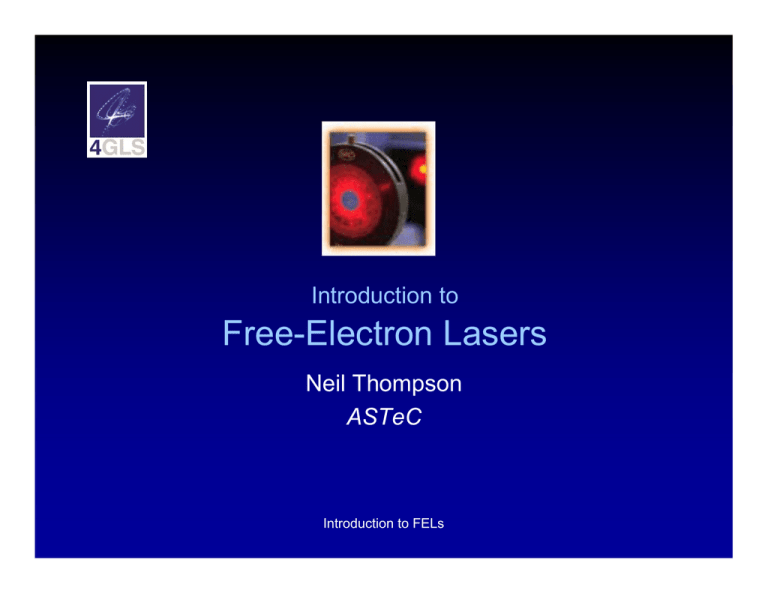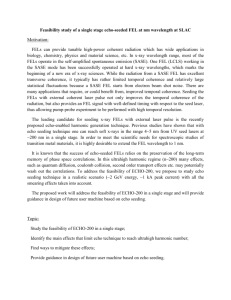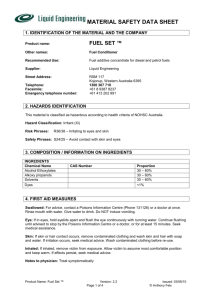Free-Electron Lasers
advertisement

Introduction to Free-Electron Lasers Neil Thompson ASTeC Introduction to FELs Outline Introduction: What is a Free-Electron Laser? How does an FEL work? Choosing the required parameters Laser Resonators for FELs FEL Output Characteristics FEL vs Conventional Laser Current Trends Introduction to FELs What is a Free-Electron Laser? Introduction to FELs What is an FEL? A beam of relativistic electrons co-propagating with an optical field through a spatially periodic magnetic field Undulator causes transverse electron oscillations Transverse e-velocity couples to E-component (transverse) of optical field giving energy transfer. Interaction between electron beam and optical field causes microbunching of electron beam on scale of radiation wavelength leading to coherent emission Introduction to FELs What is an FEL? Output is radiation that is tunable powerful coherent Introduction to FELs Types of FEL AMPLIFIER (HIGH GAIN) FEL Long undulator Spontaneous emission from start of undulator interacts with electron beam. Interaction between light and electrons grows giving microbunching Increasing intensity gives stronger bunching giving stronger emission >>> High optical intensity achieved in single pass OSCILLATOR (LOW GAIN) FEL Short undulator Spontaneous emission trapped in an optical cavity Trapped light interacts with successive electron bunches leading to microbunching and coherent emission >>> High optical intensity achieved over many passes Introduction to FELs How does a Free-Electron Laser work? Introduction to FELs How does an FEL work? y x B E vx Basic components v z B field S N S N N S N S S N Electron path Introduction to FELs E field How does an FEL work? Basic physics: Work = Force x Distance Sufficient to understand basic FEL mechanism Electric field of light wave gives a force on electron and work is done! No undulator = No energy transfer i.e. If electron velocity is entirely longitudinal then v.E = 0 Basic mechanism very simple!! Introduction to FELs How does an FEL work? Basic mechanism described explains energy transfer between SINGLE electron and an optical field. But in practice need to create right conditions for: CONTINUOUS energy transfer in the RIGHT DIRECTION with a REAL ELECTRON BEAM Introduction to FELs How does an FEL work? Q. How do we ensure continuous energy transfer over length of undulator? A. Inject at RESONANT ENERGY: This is the energy at which the electron slips back 1 radiation wavelength per undulator period: relative phase between electron transverse velocity and optical field REMAINS CONSTANT. Why does it slip back? Because electron longitudinal velocity < c: Not 100% relativistic Path length increased by transverse oscillations Introduction to FELs How does an FEL work? Ex Q. Which way does the energy flow? A. Depends on electron phase vx vx t1 Depending on phase, electron either: Loses energy to optical field and decelerates: GAIN Takes energy from optical field and accelerates: ABSORPTION t2 t3 Introduction to FELs z Does an FEL work? Q. What about a real e-beam? A. Electrons distributed evenly in phase: For every electron with phase corresponding to gain there is another with phase corresponding to absorption So at resonant energy Net gain is zero So is this the end of the story?? Introduction to FELs How does an FEL work •No! There is a way to proceed. •Energy modulation gives bunching. •At resonant energy bunching is around phase for zero net gain. •By giving the electrons a bit of an energy kick we can shift them along in phase a bit and get bunching around a phase corresponding to positive net gain. Introduction to FELs How does an FEL work? Bunching Phase corresponding to GAIN Phase corresponding to ABSORPTION E = RESONANT ENERGY t1 Bunching around phase corresponding to ZERO NET GAIN t2 E > RESONANT ENERGY t1 Bunching around phase corresponding to POSITIVE NET GAIN t2 Introduction to FELs A Simulation example Inject 20 electrons at resonance energy: zero detuning absorption gain Detuning gain • Bunching around phase correponding to zero gain • 10 electrons lose energy 0 • 10 electrons gain energy Phase Introduction to FELs A Simulation example Inject 20 electrons above resonance energy: +ve detuning absorption gain Detuning gain • Bunching around phase correponding to +ve gain • 11 electrons lose energy +ve • 9 electrons gain energy 0 Phase Introduction to FELs How does an FEL work? For ForGAIN GAIN>>ABSORPTION ABSORPTIONinject injectelectrons electronsat atenergy energy slightly slightlyhigher higherthan thanresonant resonantenergy energy ‘POSITIVE ‘POSITIVEDETUNING’ DETUNING’ >>>> >>>>NET NETTRANSFER TRANSFERof ofenergy energyto tooptical opticalfield field NB: this is only true for LOW GAIN FELs. For a HIGH GAIN FEL the maximum gain occurs at a positive detuning much closer to zero. But that’s another story…. Introduction to FELs Gain Gain Small-Signal Gain Curve 2.6 2π Spontaneous emission Energy detuning δ Shows how gain varies as a function of detuning Detuning parameter δ = 4πN(∆E/E) Maximum gain for δ = 2.6 Madey Theorem “Gain curve is proportional to negative derivative of spontaneous emission spectrum” Broadening of natural linewidth causes gain degradation Energy detuning δ Introduction to FELs The Oscillator FEL electron bunch output pulse optical pulse Electrons bunched at radiation wavelength: coherent emission Random electron phase: incoherent emission Introduction to FELs The Oscillator FEL For oscillator FEL the single pass gain is small. The emitted radiation is contained in a resonator to produce a FEEDBACK system Each pass the radiation is further amplified Some radiation extracted, most radiation reflected Increasing cavity intensity strengthens interaction leading to exponential growth: Energy transfer depends on cavity intensity Introduction to FELs Saturation: Oscillator For ZERO cavity loss intensity would increase indefinitely! In practice we have passive loss (diffraction, absorption) and active loss (outcoupling) Power lost proportional to cavity intensity As intensity rises so does power loss. Finite extraction efficiency Eventually power lost = power extracted from electrons No more growth. SATURATION. (Equivalently gain falls until it equals cavity losses) Introduction to FELs Saturation: Oscillator cavity intensity Intensity Parameters: cavity loss = 4% pass 150 gain Gain = Losses Intensity Distance along undulator pass 40 pass number Distance along undulator Introduction to FELs Amplifier-like saturation in single pass: electrons have continued to rotate in phase space until they start to reabsorb from the optical field Choosing the required parameters Introduction to FELs Required Parameters To achieve lasing with our Oscillator FEL the following parameters must be optimised Electron beam parameters Energy, Peak Current, Emittance, Energy spread Undulator parameters K, Number of periods, Period Resonator parameters Length, mirror radius of curvature For lasing must have GAIN > LOSSES Introduction to FELs Required parameters To ‘first order’ Select base parameters to optimise gain To ‘second order’ Optimise other parameters to minimise gain degradation Introduction to FELs Gain Scaling We can get an idea of how the gain should scale with various parameters by looking at our familiar equation Total charge depends on beam current Transverse velocity depends on K and beam rigidity Optical E-field depends on area of optical mode Introduction to FELs Interaction time depends on undulator length Small Signal Gain In fact, small signal, single pass maximum gain is given by: Undulator periods Undulator K Peak current Filling factor: averaged over undulator length Beam Energy Electron beam area These parameters varied to tune FEL: Introduction to FELs Small Signal Gain To summarise, at a given wavelength we need: A long enough undulator To allow sufficient interaction time A good peak current and a tightly focussed electron beam To provide high charge density A small optical cross section To provide high E field Introduction to FELs Electron beam quality Now we’ve selected parameters to optimise the gain, we need to minimise the gain degradation Gain is degraded due to energy spread emittance For optimum FEL performance a high quality electron beam is required. Introduction to FELs Energy Spread Gain SMALL SIGNAL GAIN CURVE: Small energy range for positive gain If energy spread is too large electrons fall outside detuning for positive gain 2π Energy detuning δ Introduction to FELs GAIN DEGRADATION Energy Spread Derivation of Limit on Energy Spread: FEL wavelength given by: Spontaneous emission • Expand this in Taylor series giving linewidth spread due to energy perturbation 1/2N • Require that spread is less than the natural line halfwidth so that no broadening occurs and gain is not reduced Energy detuning δ Introduction to FELs ERLP IRFEL: N=42 Gives rms energy spread of < 0.1% for negligible gain degradation Emittance Emittance controls: 1. BEAM DIVERGENCE: this effects overlap between electron beam and optical mode 2. BEAM SIZE: this affects quality of undulator field seen by electrons We can do a separate analysis for each case to see how small an emittance we need to avoid gain degradation Introduction to FELs Emittance 1: overlap • We need the electron beam contained within optical beam over whole interaction length optical beam small emittance electron beam good Interaction length large emittance bad Introduction to FELs Emittance 1: overlap Electron beam envelope equation at a waist gives electron beam Rayleigh length: Similarly, Gaussian beam equations in laser resonator gives optical Rayleigh length: For electron beam confinement need: ERLP IRFEL: So: Introduction to FELs Gives normalised emittance of < 10 mm-mrad Emittance 2 : broadening As emittance increases beam size increases so electrons move more off-axis Undulator field has a sinusoidal z-dependence on axis, so off axis electrons experience a different field (because curl B = 0) and thus a different K. wavelength shift linewidth broadening gain degradation By requiring that linewidth broadening is within the natural linewidth the following restriction can be derived: ERLP IRFEL: Introduction to FELs Gives normalised emittance of < 500 mm-mrad Longitudinal effects So far we’ve only considered an ‘infinitely long’ electron beam: we haven’t worried about the ends. Known as the STEADY STATE solution In reality we have finite electron bunches Need to extend model accordingly to include effects of PULSE PROPAGATION 2D MODEL (transverse effects) 3D MODEL (transverse + longitudinal effects ) Introduction to FELs Longitudinal effects Slippage Resonance condition: Electrons slip back by one radiation wavelength per undulator period Slippage per undulator traverse = N x wavelength. This is known as slippage length. For short electron bunch and/or long wavelength we have slippage length ≈ bunch length Effective interaction length reduced: GAIN DEGRADED. Introduction to FELs Pulse effects: Slippage Slippage Long electron bunch Undulator length optical pulse electron bunch Interaction length = undulator length Short electron bunch Reduced Interaction length Introduction to FELs Slippage length Pulse effects: Lethargy The electrons slip back over the optical pulse: bunching increases, and maximum emission occurs at end of undulator where bunching is strongest RESULT: optical pulse peaks at rear and centroid of pulse has velocity < c. Synchonism between pulse and electron bunch on next pass is not perfect Known as laser lethargy ct Pulse centroid vt (v < c) Introduction to FELs Pulse effects: Lethargy Lethargy can be offset by reducing cavity length slightly: CAVITY LENGTH DETUNING Centroid of optical pulse is then synchronised with e-bunch on successive passes BUT: as intensity increases back of pulse saturates first then rest of pulse saturates, returning centroid velocity to vacuum value c. So a single detuning can’t compensate for lethargy in both growth and saturation phases. Different detunings for gain optimisation and power optimisation Introduction to FELs Cavity length detuning one cavity length for maximum gain another cavity length for maximum power Introduction to FELs Summary 0D beam: (single electron) 1D beam: (Resonance condition) (Injection above resonance for net gain) 2D beam: transverse effects (Emittance – beam overlap and broadening 3D beam: longitudinal effects (Pulse effects – slippage and lethargy) Energy spread) Introduction to FELs Resonators for Free-Electron Lasers Introduction to FELs Optical Resonators Some general properties: Optical resonator consists of two spherical mirrors, radius of curvature R1 and R2, separated by a distance D. R1 R2 D Introduction to FELs Optical Resonators Eigenmode is not a plane wave, but a wave whose front is curved. At mirrors radius of curvature matches mirror surface Fundamental TEM00 has a Gaussian transverse intensity distribution Z=0 planar wavefront Gaussian profile 2w0 2w0 x √2 Introduction to FELs mirror curvature = wavefront curvature Gaussian profile Rayleigh length z = zR maximum curvature Optical Resonators More general properties: Length D has certain allowed values: must have optical round trip time = bunch repetition frequency Mode size at waist (R1=R2=R) : Mode size z from waist: Rayleigh length: So for a particular wavelength and D we can choose R to give required waist: defines both the Rayleigh length and the profile along the whole resonator. BUT only certain combinations of D, R are stable! Introduction to FELs Optical Resonators: Stability Wave propagation treated using element by element transfer matrices (analogy with beam optics). For stability (i.e. existence of a stable periodic solution) must have where M is round trip transfer matrix (same as for storage rings) This gives the stability condition Introduction to FELs Resonators: Stability Diagram Plot of g1 vs g2 can be used to show stable and unstable regions [1] FEL cavities required to focus beam for good coupling, so typically between confocal and concentric FELIX LANL CLIO FELI ERLP? [1] Kogelnik and Li, Laser Beams and Resonators, SPIE MS68, 1993 originally published: Applied Optics, Volume 5, Issue 10, 1550Introduction to FELs October 1966 Resonator Choice CONFOCAL PROPERTIES R1 R2 Centres of curvature far apart: insensitive to mirror alignment error Large waist = small filling factor Introduction to FELs Small mirror spot = high power density + low diffraction loss Resonator Choice Confocal Angular Alignment Sensitivity R1 R2 OPTICAL AXIS OPTICAL AXIS D Introduction to FELs Resonator Choice CONCENTRIC PROPERTIES R1 Centres of curvature close = sensitive to mirror alignment error R2 small waist = large filling factor Introduction to FELs large mirror spot = low power density + high diffraction loss Concentric Angular Alignment Sensitivity OP T IC AL A R1 XIS R2 OPTICAL AXIS D Introduction to FELs Resonator Choice From gain scaling have that gain proportional to filling factor Filling factor is averaged along undulator length, giving an optimum resonator configuration for maximum gain: Undulator length L Undulator length L Undulator length L optical electron ZR > L/3 ZR ~ L/3 OPTIMUM Introduction to FELs ZR < L/3 Resonator Choice For an FEL it is difficult to achieve a small cavity length: Restriction due to electron bunch frequency Space required for dipoles and quads So the small Rayleigh length for optimum coupling must be achieved despite a large D: This is only possible if 2R~D, giving g=1-D/R ~ -1: i.e. on the boundary of the stable region of the stability diagram PERFORMANCE VS STABILITY COMPROMISE Introduction to FELs Resonators: outcoupling There are various methods for getting the light out of the cavity: Outcoupling Method Pros Cons Hole in Mirror Broadband. Simple. Outcoupling fraction changes with wavelength. Mode distortion. Partially Transmitting Mirror No mode distortion. Not broadband: only suitable for certain wavelengths. Brewster Plate Variable outcoupling fraction. No mode distortion. Complicated. Polarisation dependent. Scraper Mirror Variable outcoupling fraction. Variable scraper position. Complicated. Introduction to FELs Free-Electron Laser Output Introduction to FELs ERLP IRFEL: FEL Output: power I = 50A E = 35MeV N = 42 Gives P = 8MW δ = 4πN(∆E/E) Maximum gain for δ = 2.6 Maximum energy that can be lost by an electron injected at peak of gain curve is δ = 2.6: no more gain after that. Gain Gain Gain curve can be used to estimate maximum output power: 2.6 2π Energy detuning δ Dividing by time, recognising that at equilibrium power extracted from electron beam = output power Introduction to FELs FEL Output At saturation pulse length matches electron bunch length Linewidth depends on pulse length (Fourier) Brightness: output is coherent, so assuming diffraction limited beam: ERLP IRFEL: P = 8 MW Wavelength = 4 micron High power enables high brightness! Gives B ~ 1026 Introduction to FELs FEL Output XUV-FEL IR-FEL 2 Peak Brightness ph/(s.0.1%bp.mm .mrad ) 1.E+30 VUV-FEL 2 1.E+26 1.E+22 Undulators coherent enhancement 1.E+18 Bending Magnet 1.E+14 1.E+10 0.001 0.01 0.1 1 Photon energy, eV Introduction to FELs 10 100 1000 FEL Output TUNABLE OUTPUT! A typical FEL facility operates at certain fixed beam energies then tunes over wavelength sub-ranges by varying undulator gap (and hence K) Introduction to FELs Free-Electron Lasers vs Conventional Lasers Introduction to FELs FEL vs Conventional Laser Conventional Laser Light Amplification by Stimulated Emission of Radiation Electrons in bound states - discrete energy levels Waste heat in medium ejected at speed of SOUND Limited tunability Limited power Continuous tunability High power Free-Electron Laser Light Amplification by Synchronised Electron Retardation ?? Electrons free - continuum of energy levels Waste heat in e-beam ejected at speed of LIGHT (and recovered in ERL) Introduction to FELs Current Trends and the way ahead Introduction to FELs Current trends Average power of FELs is increasing JLAB - record continuous average power of 2.13kW (IR) JAERI - 2kW over a 1ms macropulse (IR) High average power goal is several tens of kW JLAB upgrade promises >10kW. Wavelengths decreasing 190nm @ ELETTRA - storage ring oscillator FEL. Mirror technology limiting factor for oscillators 80nm @ TTF1 - amplifier FEL Introduction to FELs Applications Medical FELs with high-peak and highaverage power are enabling biophysical and biomedical investigations of infrared tissue ablation. A midinfrared FEL has been upgraded to meet the standards of a medical laser and is serving as a surgical tool in ophthalmology and human neurosurgery. Introduction to FELs Applications Power Beaming and Remote Sensing Introduction to FELs Applications Micromachining A free-electron laser can be used for to fabricate three-dimensional mechanical structures with dimensions as small as a micron The images above are 12-micron, micro-optical Fresnel Lens components created by laser-micromachining. Introduction to FELs The End Introduction to FELs



